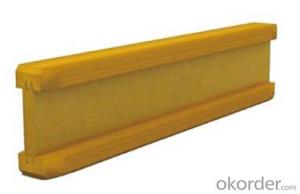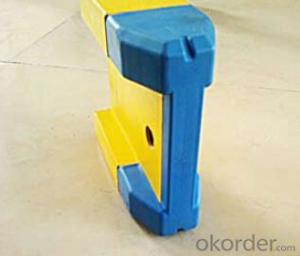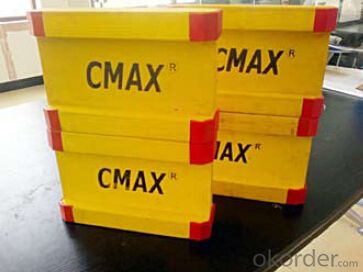Timber-beam for formwork and scaffolding system
- Loading Port:
- Tianjin
- Payment Terms:
- TT OR LC
- Min Order Qty:
- 50 m²
- Supply Capability:
- 1000 m²/month
OKorder Service Pledge
OKorder Financial Service
You Might Also Like
Characteristics:
◆ Standardized production lines.
Supply capability: 3000m/day, Lmax = 6600mm.
◆ Finger jointing of the flange and web, the strength of timber beam is highly improved.
Max. shearing force failure load:40KN
◆ Well treated to prevent from water penetration or erosion, so the service life maximally extended.
Normally, CNBM timber beam H20 can be used for 4 to 5 years, the exact using time would depend on maintenance & storage.
◆ Robust caps at the end of the girders protect against damages.
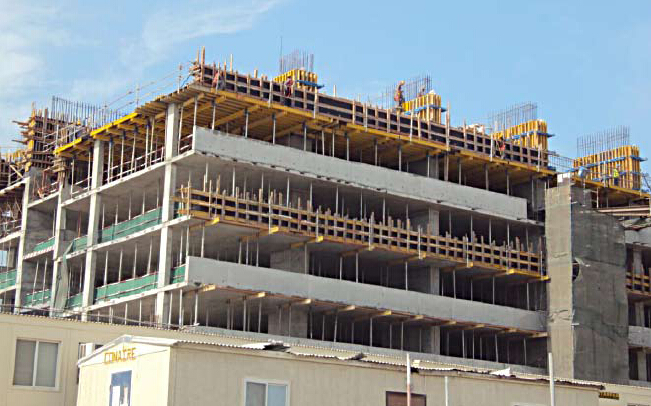
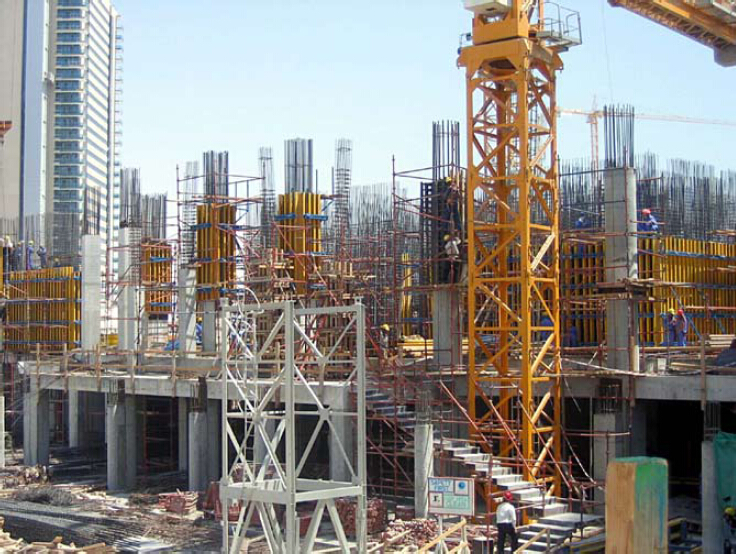
- Q: How does steel formwork impact the overall cost of a construction project?
- Steel formwork can have a significant impact on the overall cost of a construction project. While steel formwork may have a higher initial cost compared to traditional timber formwork, it offers several advantages that can result in cost savings in the long run. Firstly, steel formwork is more durable and has a longer lifespan than timber formwork. It can withstand multiple uses without significant wear and tear, reducing the need for frequent replacements. This longevity of steel formwork eliminates the costs associated with purchasing new formwork materials for each construction project, resulting in long-term savings. Moreover, steel formwork provides superior strength and stability, allowing for larger and more complex construction designs. This enhanced structural integrity can reduce the need for additional support systems, such as props or scaffolding, which can add to the overall costs of a project. Additionally, steel formwork can be easily customized to fit different shapes and sizes, minimizing wastage and optimizing material usage. Furthermore, steel formwork offers faster assembly and dismantling times compared to timber formwork. The modular nature of steel formwork allows for easy installation and removal, reducing labor costs and increasing productivity. The shorter construction cycle facilitated by steel formwork can lead to significant time savings, enabling early project completion and reducing financing costs. Another cost-saving aspect of steel formwork is its reusability. Steel formwork can be dismantled, cleaned, and reused in subsequent projects, minimizing the need for new formwork materials. This not only reduces the material procurement costs but also decreases waste generation and environmental impact. However, it is important to note that the cost impact of steel formwork will vary depending on the specific project requirements and regional factors such as material availability and labor costs. Therefore, a detailed cost analysis considering all these factors is crucial in determining the overall cost-effectiveness of steel formwork for a construction project.
- Q: What are the different components of a steel formwork system?
- To create a robust and dependable structure for concrete casting, a steel formwork system incorporates multiple components that collaborate harmoniously. The key components are as follows: 1. Panels: Comprised of top-notch steel sheets, these panels serve as the central element of the system. Their purpose is to furnish a smooth and uniform surface for pouring concrete. These panels are available in various sizes and shapes to cater to diverse construction projects. 2. Connectors: These connectors facilitate the connection of panels, ensuring their steadfastness during the concrete pouring process. They can take the form of clamps, bolts, or pins, and their function is to establish a secure and tight fit between the panels. 3. Props: Vertical supports, also known as props, are deployed to provide supplementary support and stability to the formwork system. They are engineered to endure the weight of the concrete and guard against the collapse of the formwork. Props can be adjusted in height, allowing for flexibility in formwork design. 4. Beams: Steel beams are utilized to bear the weight of the formwork system and transfer it to the ground. These beams are usually positioned horizontally and create a robust framework for the panels and other components to rest upon. They can be lengthened or shortened to accommodate project-specific requirements. 5. Bracing: To enhance the durability of the formwork system and protect it from deformation or buckling under the concrete's pressure, bracing elements such as diagonal struts and cross braces are employed. These bracing components are strategically placed to evenly distribute the load and enhance the overall stability of the system. 6. Accessories: Several accessories can be employed to enhance the functionality and efficiency of a steel formwork system. These include corner pieces, wedge bolts, release agents, and chamfer strips. These accessories contribute to the overall performance of the formwork system, ensuring seamless and precise concrete casting. In conclusion, a steel formwork system presents a comprehensive solution for constructing robust and long-lasting concrete structures. Its various components collaborate to deliver stability, flexibility, and ease of use, making it the preferred choice for diverse construction projects.
- Q: Can steel formwork be used for projects with high groundwater levels?
- Indeed, projects confronted with elevated groundwater levels can make use of steel formwork. Steel, being a robust and long-lasting substance, possesses the capability to endure the force exerted by groundwater. By forming a watertight enclosure, it effectively averts the infiltration of water into the construction site. Furthermore, steel formwork can be effortlessly tailored to meet the precise demands of the project, thereby facilitating proficient and successful construction activities amidst high groundwater circumstances.
- Q: What are the common design considerations for steel formwork in seismic areas?
- When designing steel formwork for seismic areas, there are several common considerations that need to be taken into account to ensure the safety and stability of the structure. These considerations include: 1. Material strength: The steel used for formwork should have high tensile strength and ductility to withstand the seismic forces. High-strength steel, such as Grade 60 or Grade 80, is often used to ensure the formwork can resist the lateral forces generated during an earthquake. 2. Connection details: The connections between different steel formwork components need to be carefully designed to withstand seismic loads. Proper welding or bolting techniques should be employed to ensure the connections are strong enough to resist the dynamic forces. 3. Reinforcement: Additional reinforcement, such as steel bars or mesh, may be required in the formwork design to enhance its structural integrity. This reinforcement helps to distribute the seismic forces and prevent the formation of weak points or failure zones. 4. Stiffness and rigidity: The formwork system should be designed to be sufficiently stiff and rigid to minimize deformations and prevent excessive movement during an earthquake. This can be achieved by using thicker steel plates or adding diagonal bracing elements to increase the overall stiffness of the system. 5. Anchorage and support: The formwork needs to be securely anchored to the ground or the supporting structure to prevent it from shifting or collapsing during seismic events. Adequate anchorage and support systems, such as anchor bolts or braces, should be incorporated into the design to ensure the stability of the formwork. 6. Compatibility with other building components: The design of the steel formwork should consider its compatibility with other structural elements, such as concrete walls or columns. Proper coordination and integration with other building components are essential to ensure the overall stability and seismic performance of the structure. 7. Robustness and redundancy: The formwork design should have redundancy and robustness features to withstand unexpected loading conditions or localized damage during an earthquake. This can be achieved by incorporating multiple load paths or redundant structural elements into the formwork system. Overall, the common design considerations for steel formwork in seismic areas revolve around ensuring the strength, stability, and compatibility of the formwork system to withstand the dynamic forces generated by earthquakes. By addressing these considerations, engineers can develop robust and resilient formwork designs that contribute to the overall seismic safety of the structure.
- Q: Is steel formwork more durable than other types of formwork?
- Steel formwork is indeed more durable than other types of formwork. Steel is a strong and sturdy material that can withstand heavy loads and high pressures. It is highly resistant to wear and tear, making it ideal for construction projects that require repetitive use of formwork. Unlike other materials such as wood or plastic, steel formwork does not warp, crack, or deteriorate easily over time. This durability ensures that steel formwork can be used for multiple concrete pours, reducing the need for frequent replacements and saving costs in the long run. Additionally, steel formwork is fire-resistant, which further enhances its durability and safety features. Overall, steel formwork offers superior durability compared to other types of formwork and is a reliable choice for construction projects.
- Q: What is steel formwork?
- Steel formwork is a type of temporary structure made from steel that is used in construction projects to create the desired shape and structure of concrete elements such as walls, columns, and slabs. It provides a strong and durable framework for the concrete during the pouring and curing process, ensuring accuracy and stability in the final structure.
- Q: What are the different types of steel used for formwork construction?
- There are several types of steel commonly used for formwork construction, including mild steel, high-strength low-alloy (HSLA) steel, and reinforced steel. These different types of steel offer varying levels of strength and durability, allowing for the construction of formwork that can withstand the pressures and forces exerted during the concrete pouring process.
- Q: What are the common challenges faced during steel formwork removal?
- One of the common challenges faced during steel formwork removal is the difficulty in disassembling the formwork due to the tight connections and fasteners used in its construction. Steel formwork is designed to provide a rigid structure, and as a result, it can be challenging to remove without the proper tools and techniques. Another challenge is the weight of the steel formwork. Steel is a heavy material, and when used in formwork, it can make the removal process physically demanding. Proper lifting equipment and techniques are required to safely remove the formwork without causing any injuries to the workers. Corrosion can also be a challenge during steel formwork removal. Over time, steel formwork can be exposed to moisture, which can lead to rust and corrosion. This can make the formwork more difficult to dismantle, as the rusted parts may be stuck together or weakened. Proper maintenance and regular inspections can help prevent or identify corrosion early on, reducing the challenges during removal. Additionally, the presence of concrete residue can pose challenges during steel formwork removal. Concrete can adhere to the formwork, making it difficult to separate the two. This can be time-consuming and may require additional tools or methods, such as chipping or using release agents, to facilitate the removal process. Lastly, the coordination and timing of the formwork removal can be a challenge. Removing the formwork too early can result in structural instability, while removing it too late can cause delays in subsequent construction activities. Proper planning and communication between the construction team are crucial to ensure the formwork removal is done at the right time and in the correct sequence. In conclusion, the common challenges faced during steel formwork removal include tight connections and fasteners, the weight of the formwork, corrosion, concrete residue, and coordination and timing. Overcoming these challenges requires proper tools, techniques, maintenance, and effective communication among the construction team.
- Q: How does steel formwork affect the overall construction site dust control?
- The utilization of steel formwork has a positive influence on dust control at construction sites. In comparison to alternative formwork materials like wood or plastic, steel formwork is more enduring and less prone to deterioration or breakage, leading to the generation of dust particles. Consequently, the construction process will produce less dust. Moreover, steel formwork is typically constructed to fit tightly together, reducing the presence of gaps and spaces where dust can gather. This outcome creates a cleaner and more regulated environment at the construction site since there are fewer areas for dust to settle and become airborne. Additionally, steel formwork is reusable, minimizing the necessity for frequent replacements. Consequently, the amount of waste generated, including dust-producing debris from removing and replacing formwork, is reduced. In summary, the adoption of steel formwork plays a significant role in enhancing dust control at construction sites, thereby fostering a safer and healthier work environment for laborers and decreasing the potential adverse effects of dust on nearby communities and the environment.
- Q: How does steel formwork handle vibrations from construction equipment?
- Renowned for its exceptional strength and durability, steel formwork excels at handling vibrations caused by construction equipment. Its rigidity and stability enable it to absorb and distribute vibrations with great efficiency, minimizing their impact on the structure under construction. Comprising interconnected steel panels securely fastened together, steel formwork creates a robust framework. This interconnected design effectively dissipates vibrations throughout the entire formwork system, preventing concentrated impacts on specific areas. Consequently, vibrations are dispersed and absorbed without causing significant damage to the formwork or the poured concrete. Furthermore, steel formwork boasts a high load-bearing capacity, enabling it to withstand the weight and vibrations produced by heavy construction equipment. The robust nature of steel ensures its integrity and stability, even in the face of intense vibrations. Moreover, steel formwork surpasses other materials, like timber, in terms of resistance to warping or deformation caused by vibrations. Its structural integrity remains intact, even when subjected to repetitive or intense vibrations, ensuring the accuracy and stability of the formwork system. In summary, steel formwork proves itself as an ideal choice for handling vibrations from construction equipment due to its strength, stability, and effective absorption and distribution of vibrations. Its durability and resistance to warping make it a reliable solution for meeting the rigorous demands of construction projects.
Send your message to us
Timber-beam for formwork and scaffolding system
- Loading Port:
- Tianjin
- Payment Terms:
- TT OR LC
- Min Order Qty:
- 50 m²
- Supply Capability:
- 1000 m²/month
OKorder Service Pledge
OKorder Financial Service
Similar products
Hot products
Hot Searches
Related keywords
